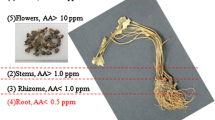Abstract
This paper outlines the importance of quality control of herbal remedies by providing an overview of the types of toxic and pathogenic contaminants which may OCCUK These include toxic boranicals, micro-organisms, microbial toxins, pesticides, fumigation agents, radioactivity, toxic metals, synthetic pharmaceuticals, and animal substances. Academia, government, the herbal industry, and the pharmaceutical industry must work together to develop practical methods of improving the safety of herbal remedies.
Similar content being viewed by others
References
De Smet PAGM. Toxicological outlook on the quality assurance of herbal remedies. In: De Smet PAGM, Keller K, Hansel R, Chandler RF, eds. Adverse Effects of Herbal Drugs. Volume 1. Heidelberg: Springer-Verlag; 1992:1–72.
De Smet PAGM. Health risks of herbal remedies. Drug Safety. 1995;13:81–93.
Schier W, Sachsa B, Schultze W. Actual adulteration of herbal drugs. 5. Communication–birch leaves, javatea, scotch broom flower, Mexican tea, and Iceland moss. Dtsch Apoth Ztg. 1994; 134:4569–4576.
Greinwald R, Lurz G, Witte L, Czygan F-C. A survey of alkaloids in Spartium junceum L. (Genisteae-Fa-baceae). ZNaturforsch SectCBiosci. 1990;45:1085–1089.
Barboni L, Manzi A, Bellomaria B, Quinto AM. Alkaloid content in four Spartium junceum populations as a defensive strategy against predators. Phy-tochemistry. 1994;37:1197–1200.
De Smet PAGM. Aristolochia species. In: De Smet PAGM, Keller K, Hansel R, Chandler RF, eds. Adverse Effects of Herbal Drugs. Volume 1. Heidelberg: Springer-Verlag; 1992:79–89.
De Smet PAGM. Notes added in proof. In: De Smet PAGM, Keller K, Hansel R, Chandler RF, eds. Adverse Effects of Herbal Drugs. Volume 3. Heidelberg: Springer Verlag; 1997:229–240.
Anonymous. Drug development from natural products. Pharm J. 1995;255:430–431.
De Smet PAGM, Elferink F. Verpoorte R. Links-draaiend tetrahydropalmatine in Chinese tablet. Ned Tijdschr Geneesk. 1989;133:308.
Horowitz RS, Gomez H, Moore LL, Fulton B, Feld-haus K, Brent J, Stermitz FR, Beck JJ, Alessi JR, De Smet PAGM. Jin Bu Huan toxicity in children—Colorado 1993. MMWR. 1993;42:633–636.
Woolf GM, Petrovic LM, Rojter SE, Wainwright S, Villamil FG, Katkov WN, Michieletti P, Wanless IR, Stermitz FR, Beck JJ, Vierling JM. Acute hepatitis associated with the Chinese herbal product Jin Bu Huan. Ann Intern Med. 1994;121:729–735.
Hsu CK, Leo P, Shastry D, Meggs W, Weisman R, Hoffman RS. Anticholinergic poisoning associated with herbal tea. Arch Intern Med. 1995;155:2245–2248.
De Smet PAGM. Teucrium chamaedrys. In: De Smet PAGM, Keller K, Hansel R, Chandler RF, eds. Adverse Effects of Herbal Drugs. Volume 3. Heidelberg: Springer-Verlag; 1997:137–144.
De Smet PAGM, Smeets OSNM. Potential risks of health food products containing yohimbe extracts. Br Med J. 1994;309:958.
De Smet PAGM. Tripterygium species In: De Smet PAGM, Keller K, Hansel R, Chandler RF, eds. Adverse Effects of Herbal Drugs. Volume 3. Heidelberg: Springer-Verlag; 1997:145–163.
Anonymous. European Pharmacopoeia. Third Edition. Strasbourg: Council of Europe; 1996.
Farber JM, Carter AO, Varughese PV, Ashton FE, Ewan EP. Listeriosis traced to the consumption of alfalfa tablets and soft cheese. New Engl J Med. 1990:322:338.
Ishikawa K, Matsui K, Madarame T, Sato S, Oikawa K, Uchida T. Hepatitis E probably contracted via a Chinese herbal medicine, demonstrated by nucleotide sequencing. J Gastroenterol. 1995;30:534–538.
Scheer R. Influencing of the limulus amebocyte ly-sate test by mistletoe lectins. Arzneim Forsch. 1993; 43:795–800.
Hogan III RP. Hemorrhagic diathesis caused by drinking an herbal tea. JAMA. 1983;249:2679–2680.
Anonymous. Evaluation of certain food additives and contaminants. 33rd Report of the Joint FAO/ WHO Expert Committee on Food Additives. Technical Report Series 776. Geneva: World Health Organization; 1989.
Anonymous. Evaluation of certain food additives and contaminants. 41st Report of the Joint FAO/WHO Expert Committee on Food Additives. Technical Report Series 837. Geneva: World Health Organization; 1993.
Anonymous. Evaluation of certain food additives and contaminants. 22nd Report of the Joint FAO/WHO Expert Committee on Food Additives. Technical Report Series 631. Geneva: World Health Organization; 1978.
Abt AB, Oh JY, Huntington RA, Burkhart KK. Chinese herbal medicine induced acute renal failure. Arch Intern Med. 1995;155:211–212.
Nelson L, Shin R, Hoffman R. Aplastic anemia induced by an adulterated herbal medication. J Toxicol Clin Toxicol. 1995;33:467–470.
Gertner E, Marshall PS, Filandrinos D, Potek AS, Smith TM. Complications resulting from the use of Chinese herbal medications containing undeclared prescription drugs. Arthritis Rheum. 1995;38:614–617.
Van der Stricht BI, Parvais OE, Vanhaelen-Fastré RJ, Vanhaelen MH. Remedies may contain cocktail of active drugs. Br Med J. 1994;308:1162.
Ros JJW, Pelders MG, DeSmet PAGM. A case of positive doping with a botanical food supplement. Pharm World Sci. 1999;21:44–46.
Ko RJ, Greenwald MS, Loscutoff SM, Au AM, Ap-pel BR, Kreutzer RA, Haddon WF, Jackson TY, Boo FO, Presicek G. Lethal ingestion of Chinese herbal tea containing Ch’an Su. West J Med. 1996; 164: 71–75.
Kommission E. Preparation monographs. Dtsch Apoth Ztg. 1993;133:2791–2794.
Anonymous. Anthranoid-containing human medicines. Pharm Ztg. 1994;139:2432.
De Smet PAGM. Spirulina species. In: De Smet PAGM, Keller K, Hansel R, Chandler RF, eds. Adverse Effects of Herbal Drugs. Volume 3. Heidelberg: Springer Verlag; 1997:129–135.
Author information
Authors and Affiliations
Rights and permissions
About this article
Cite this article
de Smet, P.A.G.M. Overview of Herbal Quality Control. Ther Innov Regul Sci 33, 717–724 (1999). https://doi.org/10.1177/009286159903300308
Published:
Issue Date:
DOI: https://doi.org/10.1177/009286159903300308




